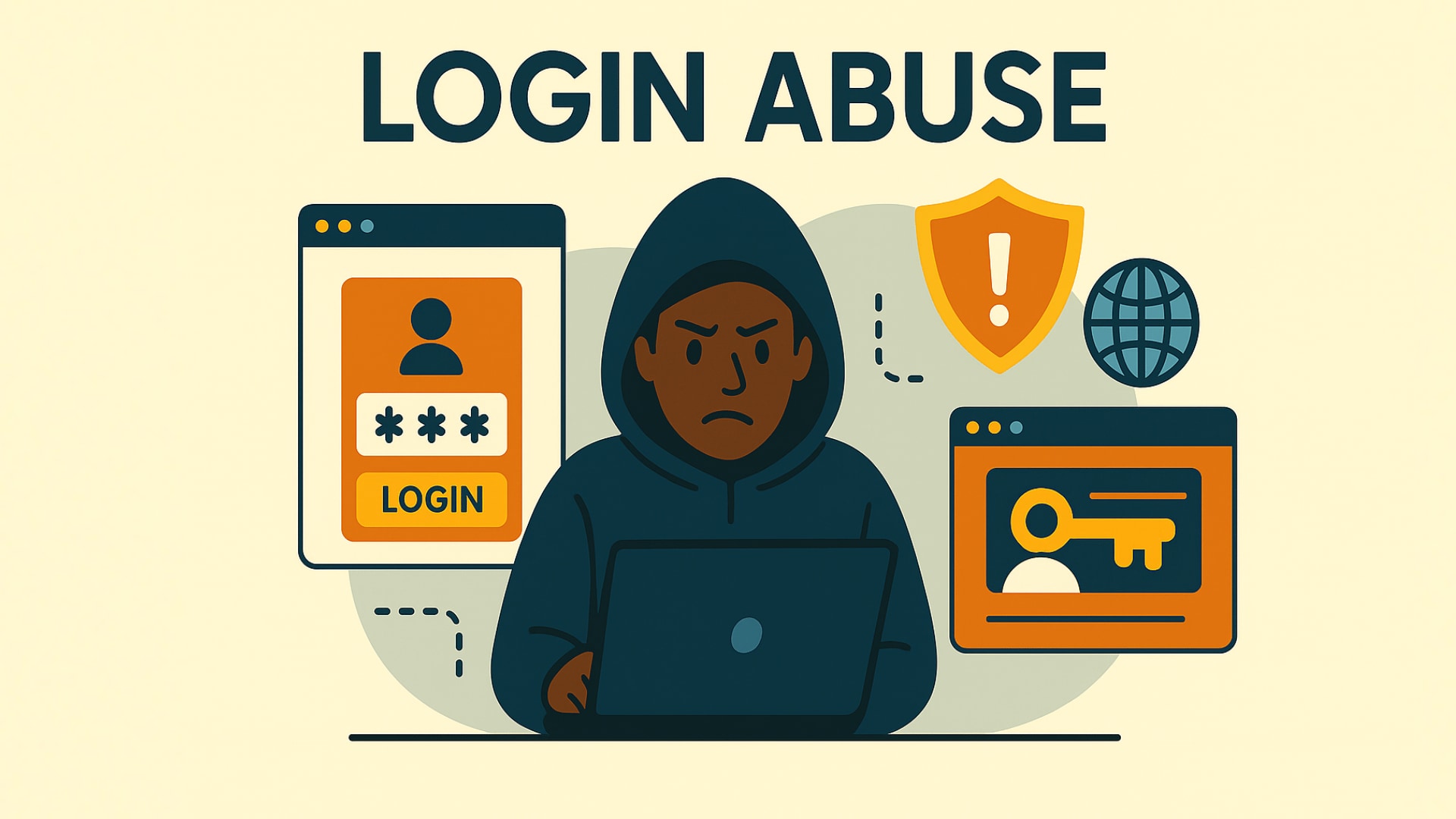
Login abuse is a serious and growing problem that affects individuals and businesses alike. It occurs when attackers exploit vulnerabilities in the login process to gain unauthorized access to user accounts, often leading to stolen data, financial losses and severe damage to a company’s reputation. Whether you’re running an online store, offering digital services, or managing a user-driven platform, understanding login abuse is crucial. In this article, we’ll dive into what login abuse really means, how it works and how you can protect your business and your users from this ever-evolving threat.
This article will explore the nature of login abuse, how it works and the steps you can take to defend against it, including the role CAPTCHA plays in enhancing security.
Table of contents
What Is Login Abuse?
Login abuse occurs when malicious actors attempt to gain unauthorized access to user accounts through various means. Such as brute-force attacks, credential stuffing or exploiting weak authentication protocols. The primary goal of login abuse is to bypass security mechanisms and steal sensitive information, control accounts, or launch further attacks.
Unlike other forms of cybercrime that rely on stealing data directly, login abuse targets the authentication process itself. By focusing on bypassing login screens or circumventing login protections, cybercriminals can gain access to accounts without needing to exploit vulnerabilities within a system.
There are several different tactics used in login abuse, each with its own methods for breaching login credentials and bypassing security layers. These include brute-force attacks, credential stuffing and session hijacking, all of which aim to overwhelm or trick login systems.
Types of Login Abuse
Login abuse can take many forms, but here are the most common methods attackers use to exploit login systems:
Brute-Force Attacks
A brute-force attack is one of the most straightforward methods used in login abuse. In this type of attack, the malicious actor uses an automated tool to systematically try every possible combination of passwords until the correct one is found. While brute-force attacks can be time-consuming, they are still effective when the target uses weak passwords or does not have account lockout mechanisms in place.
Typically, attackers will target accounts with simple or commonly used passwords, relying on the fact that many people reuse passwords across multiple platforms. Once they guess the correct password, they can gain full access to the compromised account.
Credential Stuffing
Credential stuffing is a type of attack that has gained popularity because it exploits large datasets of stolen login credentials. Attackers use automated bots to test previously stolen username and password combinations across multiple websites, aiming to find a match.
Credential stuffing works because many users reuse the same login details across multiple services. When hackers steal login credentials from one site—say, from a data breach—they can attempt to use those same credentials to access other accounts on different platforms. This makes credential stuffing a particularly dangerous form of login abuse, especially for businesses with a large number of users.
Session Hijacking
Session hijacking involves stealing a valid session token to impersonate a user without needing to know their login credentials. Once a user logs in to a website, they are typically assigned a session token that keeps them logged in for a period of time. Attackers can hijack this session by intercepting the token, allowing them to access the user’s account without needing to authenticate.
Session hijacking is often carried out using methods like man-in-the-middle (MITM) attacks or through the exploitation of insecure websites that don’t encrypt session tokens properly. It’s particularly dangerous because the attacker can bypass the usual login procedures entirely, making it harder to detect.
Phishing for Login Details
Phishing is another common method for login abuse. In a phishing attack, a cybercriminal impersonates a legitimate service and tricks the user into providing their login details. Often by sending fraudulent emails that look like they come from a trusted source. Phishing emails often direct users to fake login pages that closely mimic real ones, where the victim unknowingly enters their username and password.
Phishing attacks often occur in tandem with other forms of login abuse. For example as credential stuffing, where attackers use the stolen login credentials to attempt unauthorized access to multiple accounts.
Consequences of Login Abuse
The impact of login abuse can be severe, both for users and businesses. Here’s a look at some of the potential consequences:
Financial Loss
One of the most immediate consequences of login abuse is financial loss. If attackers gain access to user accounts, they can make unauthorized transactions, steal funds, or misuse payment details. For businesses, the financial impact includes chargebacks, fines for data protection violations, and the cost of addressing security breaches.
Loss of Customer Trust
For businesses, one of the most damaging consequences of login abuse is the loss of customer trust. When users’ accounts are compromised, it erodes their confidence in the platform’s ability to protect their sensitive information. Customers who feel their accounts are insecure may stop using the service altogether, leading to a drop in engagement and customer retention.
Reputation Damage
Login abuse can also lead to significant reputational damage. News of a breach or hack that resulted from login abuse can spread quickly, damaging a business’s reputation. Customers may view the platform as insecure, leading to negative reviews, press coverage and diminished brand credibility.
Regulatory Penalties
Organizations that fail to implement adequate security measures to protect user accounts from login abuse may face regulatory penalties. Depending on the jurisdiction, businesses could be fined for violating data protection laws, such as the GDPR or CCPA, especially if the breach results in the exposure of sensitive personal data.
Protection and Prevention Against Login Abuse
There are several strategies that businesses can implement to protect against login abuse and enhance the security of user accounts. Here are some of the most effective measures:
Strong Password Policies
Enforcing strong password policies is one of the simplest and most effective ways to defend against login abuse. Encourage users to create complex passwords that are difficult for attackers to guess. Passwords should include a combination of uppercase and lowercase letters, numbers and special characters. Additionally, businesses should avoid allowing users to reuse passwords across multiple accounts.
Multi-Factor Authentication (MFA)
Multi-factor authentication (MFA) prevents unauthorized access, even if login credentials are stolen. It adds a second verification step, like an OTP sent via SMS or an authentication app. Attackers need both the password and the second factor, making unauthorized access more difficult.
Captcha Solutions for Login Forms
Implementing CAPTCHA solutions, like those provided by Captcha.eu, can greatly reduce the risk of login abuse by blocking automated bots from attempting multiple logins. Captcha.eu is designed to be invisible, user-friendly, and barrier-free. Unlike traditional systems that require users to solve puzzles or complete tasks, our solution works seamlessly in the background without disrupting the user experience. By adding this effortless layer of protection, businesses can effectively prevent brute-force and credential stuffing attacks, ensuring only legitimate users can access their accounts.
Rate Limiting and Account Lockouts
Rate limiting is another effective defense against login abuse. By limiting the number of login attempts within a short period, businesses can prevent brute-force and credential stuffing attacks. If an account experiences too many failed login attempts, businesses can enforce account lockouts or delays before further attempts are allowed. This significantly lowers the success rate of automated attacks.
Educating Users About Phishing
Educating users about phishing scams is essential in protecting against login abuse. Users should be informed about the risks of phishing and trained on how to recognize suspicious emails, links, or websites. By promoting best practices for online security, such as double-checking URLs and never entering login details on untrusted sites, businesses can help reduce the effectiveness of phishing attacks.
Conclusion
Login abuse is a serious threat that can compromise user accounts, lead to financial losses and damage a business’s reputation. By understanding the different types of login abuse and implementing a combination of strong security measures — such as strong password policies, MFA, CAPTCHA and rate limiting — businesses can effectively protect their systems and users from malicious attacks.
At Captcha.eu, we offer easy-to-integrate, privacy-compliant CAPTCHA solutions that add an extra layer of protection to your login forms, helping to safeguard your platform from automated login abuse. Investing in robust security measures is essential for maintaining the trust of your users and ensuring the long-term success of your business.
FAQ – Frequently Asked Questions
What is login abuse?
Login abuse refers to unauthorized attempts by attackers to gain access to user accounts through methods like brute-force attacks, credential stuffing, or exploiting weak authentication systems. The goal is to bypass security measures and steal sensitive data or control user accounts.
How does login abuse work?
Login abuse typically involves automated attacks that use bots to try multiple login attempts, often exploiting weak passwords or stolen credentials. Attackers may also use phishing or session hijacking to access accounts without needing passwords, making login abuse a versatile and dangerous threat.
What are brute-force attacks in login abuse?
A brute-force attack is when an attacker tries multiple combinations of passwords until they find the correct one. This method relies on the attacker’s ability to automate the process, making it easier to overwhelm accounts with weak passwords.
What is credential stuffing?
Credential stuffing is when attackers use stolen login credentials from one website to try and gain access to accounts on other websites. Since many people reuse passwords across different platforms, this type of attack can be highly effective.
How can CAPTCHA help prevent login abuse?
CAPTCHA systems, such as those offered by Captcha.eu, can help prevent login abuse by blocking automated bots from attempting multiple login attempts. CAPTCHA challenges ensure that only real users — not bots — can access login forms, effectively reducing brute-force and credential stuffing attacks.
100 free requests
You have the opportunity to test and try our product with 100 free requests.
If you have any questions
Contact us
Our support team is available to assist you.




